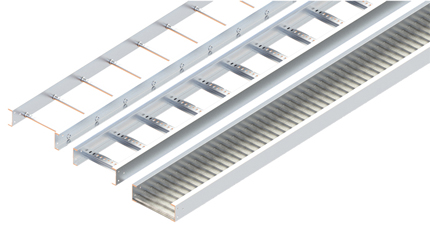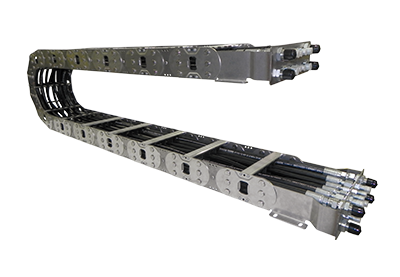Cabling in a motion control system can run the gamut from a single wire running to a single-axis direct drive, to a complicated system of expensive cables and wiring on multi-axis robots. As a result, it is necessary to consider cable management in your system design. A simple design may only require twist-tie type bundlers but as systems become more complex, with longer, heavier cables, you may need to upgrade to cable trays or cable carriers to prevent sagging and undue strain on cables.
Cable trays for static cable runs

Cable trays are best suited to stationary applications. These devices route cables in a system, providing protection from contaminants and necessary ventilation while keeping different cable types separated.
Featuring a U-shaped open design, the cables are simply placed into the tray, which can be closed or open to the air. Typically manufactured from stainless steel, aluminum, plastic, or fiberglass, they may be designed ladder style or in solid, ventilated or perforated designs with knockouts for cable exits.
It is important to consider the cables that are being routed when choosing a cable tray, including its weight and diameter. On a related note, be aware of the span between supports and the cable run distance, as cable weight can have an impact here. Finally, understand the application where the cables are used; for instance, if they need to be protected from contaminants with a closed design or if they will require ventilation.
Cable carriers prevent cable damage in dynamic motions

Cable carriers are advanced components that house cables and hose in motion systems. Available in metal or plastic designs, they help prevent sagging, tangling and crushing of cables in robotics, machine tool, and large off-road and industrial machinery.
Unlike cable trays or ladders, these devices are best suited to systems that require movement, such as robotics, machine tool and large off-road and industrial machinery. They can support the heavy weight of numerous cables and hoses, without sagging or putting stress on the cabling. They also prevent cable from tangling and getting caught in moving parts of a machine.
Two styles are available: closed or open. Closed carriers protect cables from environmental damage posed by contaminants like metal shavings, while open carriers offer visual and quick and easy access.
Plastic cable carriers, made from high-performance polymer or nylon, offer reduced weights while being corrosion resistant in hostile environments. Some polymer designs resist seawater and mineral oils, for use in harsh applications.

Plastic cable carriers can be easily opened and disassembled. They feature a modular design, for easy configuration to most applications. The easy-to-maintain designs mean damaged or broken links can simply be removed and substituted with a new link. Some plastic carriers can be opened by hand.
Steel and other metal alloy carriers are best suited for heavy mechanical loads that run long distances carrying large cables and hose. Steel cable carriers are designed to handle harsh environments—even long-term temperatures above 600° without negative impact.
They also offer high resistance to many harsh and corrosive chemicals, so are usually found where maintenance is difficult. These extreme applications include everything from mining to marine and oil and gas to foundries.


That is what one needs to do to in motion application. The tips are very informative and also not too long. Really appreciate.